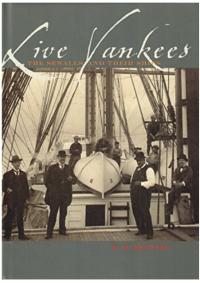 Live Yankees, the Sewalls and their Ships is a fascinating and sweeping history of one family from Bath, Maine, which built and operated over one hundred merchant ships, mostly square riggers in the 19th and early 20th centuries. It offers a complex and intriguing portrait of the shipbuilders, ship owners, captains and crews who helped drive the meteoric rise of the US sailing merchant fleet in the mid-1800s and presided over its fall in the wake of the arrival of steamships.
Live Yankees, the Sewalls and their Ships is a fascinating and sweeping history of one family from Bath, Maine, which built and operated over one hundred merchant ships, mostly square riggers in the 19th and early 20th centuries. It offers a complex and intriguing portrait of the shipbuilders, ship owners, captains and crews who helped drive the meteoric rise of the US sailing merchant fleet in the mid-1800s and presided over its fall in the wake of the arrival of steamships.
Bill Bunting accepted the daunting task of taking 315 linear feet of documents that comprise the Sewall Family Papers and translating them into a coherent and entertaining account. In the hands of a lesser writer, the book could have ended up as a dry and plodding scholarly work. Fortunately, Live Yankees is anything but. In addition to wonderful writing, the book is full of fascinating photographs of both the people and the ships described within its pages.
The characters Bunting illuminates, often through the use of private and business correspondence, as well shipyard records and ships logs, are vivid and engaging. The Sewalls come off as being shrewd and tight-fisted, ready to squeeze every penny from the often low margin business of shipping. The portraits of the family patriarchs, from William Dunning Sewall of the early 1800s to Arthur Sewall who died in 1900, are nuanced and revealing. It is difficult not to feel both admiration and unease with these men, to admire their enterprise and also be put off by the avarice beneath their usually genteel exteriors. Arthur Sewall, in addition to being a shipbuilder and ship owner, was also a bank president, director of a railroad, and the Democratic Party vice presidential candidate in 1896 on William Jennings Bryan’s first run for president. He was indeed a larger-than-life figure yet Bunting does an excellent job infusing him with flesh and blood; full of confidence and contradiction. Bunting describes him as “small town, dry humored, even quaint, Down East nabob. … As unflappable and phlegmatic as ever – an enigma wrapped in a veil of pungent cigar smoke…”
The images Bunting presents of the captains, mates and the ships they sailed are also fascinating. He follows the ships and their masters through gales, fires, shifting cargo, groundings, mutinies and the outright disappearance of ships without a trace. We catch a glimpse of the various trades – wool, guano, sugar, coal, timber, case oil as well as general cargo – that drove the ships and men around the globe.
The captains and mates of these ships were intriguing and complex characters. You have to admire their seamanship and courage while often being horrified by their brutality. It is hard to judge from more than a century later how much discipline was actually required to manage the unruly sailors of the day. All the same, the world-wide reputation of the Yankee “blood-boats” was, no doubt, well earned.
The Sewalls were roundly criticized for the treatment of their crews, particularly toward the end of the nineteenth century, as smaller crews were asked to sail larger and larger ships. Nevertheless, the best and worst of the Sewall captains and mates are fascinating to read about. Captain Ned Sewall, one of only two members of the family to choose the sea for a career, was a disaster, notable for his brutality, drunkenness and complete mismanagement of vessel accounts. On the other hand, Captain Thomas Burton “Burt” Gaffney, as captain of the Arthur Sewall, one of the Sewall’s iron ships, faced horrific weather, fire, shifting cargo and constant leaking from failed rivets and seams, yet never had reports of “sailor troubles,” as the charges of brutality were euphemistically known. On April 2, 2007, the Arthur Sewall under the command of Captain Gaffney sailed from Philadelphia with coal for Seattle and was never seen or heard from again.
The Sewalls missed their great opportunity to invest in steamship lines and resolutely stuck to their square-riggers and schooners. As the markets turned against them, the old ships were sold off. The four-masted bark Edward Sewall was sold to the Texas Company in 1916, who then sold her to Alaska Packers in 1922. Her last voyage was to Japan in 1936, after which she was scrapped. In 1915, the Sewall ship William P. Freye became the first American ship sunk in World War I, when she was sunk by a German commerce raider. The four-masted Sewall bark Dirigo was sold in 1915 and sunk by a German submarine. The Sewall ship Indiana built in 1876 and sold in 1898, ended her life in Hollywood, being featured several movies. She finally blew ashore in Long Beach, California and burned that year to celebrate Harbor Day.
And so it goes – so many ships and so many stories. Bill Bunting has done a marvelous job in pulling them all together in one book, in the story of one extraordinary family. Live Yankees, the Sewalls and their Ships is close to five hundred pages long, including appendices. When I first sat down to read it, I wondered whether I would learn more about the Sewalls than I cared to know. That was not the case. Like all well-written history, I left wanting to learn more. Live Yankees, the Sewalls and their Ships is well-written history indeed. Highly recommended.
